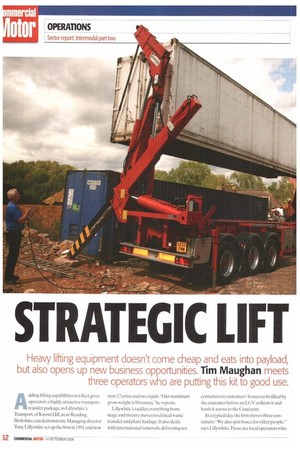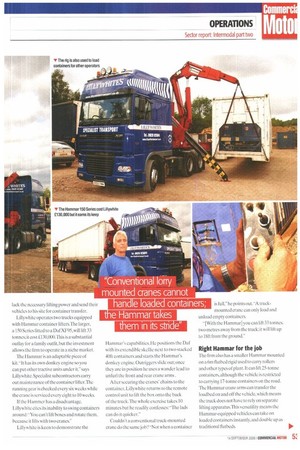STRIkTEG C LIFT
Page 52

Page 53

Page 56

If you've noticed an error in this article please click here to report it so we can fix it.
Heavy lifting equipment doesn't come cheap and eats into payload, but also opens up new business opportunities. Tim Maughan meets three operators who are putting this kit to good use.
Adding lifting capabilities to a fleet gives operators a highly attractive transporttransfer package, as Lillywhite's Transport, of Knowl Hill,near Reading, Berkshire,can demonstrate. Managing director Tony Lillywhite set up the firm in 1991 and now runs 12 artics and two rigids."Our maximum gross weight is 80 tonnes,he reports.
Lillywhite's tackles everything from stage and theatre moves to clinical waste transfer and plant haulage. It also deals with international removals, delivering sea containers to customers' homes to be filled by the customer before an LCIV collects it and hauls it across to the Continent.
In a typical day the firm moves three containers."We also spin boxes for other people," says Lillywhite.These are local operators who lack the necessary lifting power and send their vehicles to his site for container transfer.
Lillywhite operates two trucks equipped with Hammar container lifters, The larger, a 150 Series fitted to a Daf XF95,will lift 33 tonnes; it cost £130,000.This is a substantial outlay for a family outfit, but the investment allows the firm to operate in a niche market.
The Hammar is an adaptable piece of kit. "It has its own donkey engine so you can put other tractive units under it," says Lillywhite. Specialist subcontractors carry out maintenance of the container lifter.Thc running gear is checked every six weeks while the crane is serviced every eight to 10 weeks.
If the Hammer has a disadvantage. I.illywhite cites its inability to swing containers around: "You can't lift boxes and rotate them, because it lifts with two cranes."
Lillywhite is keen to demonstrate the 14ammar's capabilities. He positions the Dal with its extendible skellie next to two stacked 40ft containers and starts the Hammar's donkey engine. Outriggers slide out; once they are in position he uses a wander lead to unfurl the front and rear crane arms.
After securing the cranes' chains to the container, Lab/white returns to the remote control unit to lift the box onto the back of the truck.The whole exercise takes 10 minutes but he readily confesses:"The lads can do it quicker."
Couldn't a conventional truck-mounted crane do the same job'? "Not when a container is full," he points out, "A truckmounted crane can only load and unload empty containers.
"[With the Hammar) you can lift 33 tonnes, two metres away from the truck: it will lift up to 18ft from the ground."
Right Hammar for the job
The firm also has a smaller Hammar mounted on a 6m flatbed rigid used to carry rollers and other types of plant. It can lift 25-tonne containers,although the vehicle is restricted to carrying 17-tonne containers on the road. The Hammar crane arms can transfer the loadbed on and off the vehicle, which means the truck does not have to rely on separate lifting apparatus:This versatility means the Hammar-equipped vehicles can take on loaded containers instantly, and double up as traditional flatbeds. 10' The Gatwick Group specialises in moving, lifting and positioning plant and construction loads. It has 10 drawbar combinations and two artics, all equipped with truck-mounted cranes (TMCs). Contracts manager Kevin Findley readily admits that the firm charges more for its services than other TMC operators. But wise clients are prepared to pay a premium for the right level of service and the company has no shortage of repeat business. -We know our customers and they know us," he says.
On the building side, the company takes on entire lifting projects. Findley carries out an initial survey of a site to work out the type of TMC that is required before the trucks get on with the job.
In October the firm will be putting loading bridge materials (the tubes that connect aircraft to terminals) into place at Gatwick Airport.To handle this kind of work Findley has an impressive array of cranes at his disposal.They range from 7tm to 80tm, with just about every size in between.
"We choose Hiab for their remote-control systems; we had the first remote-controlled Hiab in the country," he says.
Every Gatwick Group TMC is equipped for a remote control facility This kit does not come as standard; it costs the Gatwick Group 1..3,50044,(X10 per vehicle to install remotecontrol units.
Findley hands us a photograph of himself, remote control in hand, lowering a railway carriage. Remote control systems allow the operator to stand back from the job and look at the wider picture as consignments are raised and lowered. Systems manager Maria Ridout points to another picture which shows an operator holding a remote control unit on a building's roof. Even from this distance he can dictate the 'FMC's movements down below.
The company takes on qualified truck and TMC operators, but Ridout reports that all recruits go through training to tailor their skills to the Gatwick Group's working methods. "It costs us between £1,000 and El 500 per driver to put them through our induction programme," he adds.
Her husband Mark is the daily operations manager.The trick to managing the efficient movements of the many TMCs, he explains, is canny routeing and knowing where any particular crane is going to be needed at a specific time."You try and work out your day, get a nice little circle going," he adds.
LGVs need TMCs, OK
TMCs can transform LGVs into a complete transport and drop package but, they have their limitations. On the larger projects. Findley subcontracts mobile cranes on one occasion a 250tm model.
The Gatwick Group sees its truck/crane rigs as complete entities. "We occasionally use a truck as a flat," says Findley."but we won't reduce our rates just because we have a crane on the vehicle." He adds that MD BobToon always tries to look five years ahead, so the firm can adapt to change.'The Gatwick Group buys its gear outright. so purchases must bring in business.Airports provide the firm with a lot of work;it will be heavily involved in the refurbishment of Heathrow's Terminal 2.
Lifting capabilities make the Gatwick Group what it is."If we didn't have cranes, I wouldn't be sitting here now," Findley concludes. 'They are the lifeblood of the company."
































































































































































































